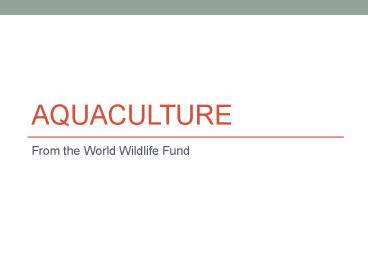AquaCulture - PowerPoint PPT Presentation
1 / 14
Title:
AquaCulture
Description:
AquaCulture From the World Wildlife Fund Fish, shrimp and shellfish are farmed Fish farms compete for space: example shrimp farms in Madagascar occupy habitat in ... – PowerPoint PPT presentation
Number of Views:311
Avg rating:3.0/5.0
Title: AquaCulture
1
AquaCulture
- From the World Wildlife Fund
2
Fish, shrimp and shellfish are farmed
3
Fish farms compete for space example shrimp
farms in Madagascar occupy habitat in mangrove
swamps
4
Pollution from open net cages
- The waste waters can contain
- Chemicals
- Pharmaceuticals
- Fish faeces
- Unused fish feed
- These can be toxic to the wild aquatic species
5
Could aquaculture cause antibiotic resistance?
6
Exotic escapees compete for food and habitat and
compete with wild species
Wild salmon are now outnumbered by escaped farmed
salmon in Norway
7
Example 300,000 farmed salmon were lost when 12
cages broke in Shetland!
8
Spread of disease to wild marine species
Sea lice from farmed salmon can infect wild fish
Wild fish can also be exposed to viruses and
other diseases from fish farms
9
Wild Atlantic Salmon crisis from sea lice and
escaped farmed salmon
10
Genetically modified salmon
This salmon has been genetically modified so that
it grows faster. Should it be labeled in the
grocery store. http//www.dailyfinance.com/2010/09
/21/fda-hearings-on-gm-salmon-are-a-fish-fight-ove
r-labeling/
11
Aquaculture is contributing to overfishing
through the use of wild-caught fish as feed for
farmed fish.
These fish pellets are made of wild fish.
Up to 22 kg of wild-caught fish is needed just to
produce of 1 kg farmed tuna Up to 4 kg of
wild-caught fish is needed to produce 1 kg of
farmed salmon
12
Wild-caught fish, which are raised in cages, are
devastating wild populations
Tuna farming involves capturing wild tuna and
fattening them in cages. This stops the young
fish from reproducing and renewing the wild
stocks.
13
Wild animals preying on fish farms are often
culled (killed)
- Many animals such as wild seals, seabirds, and
sharks to molluscs and crustaceans are attracted
to fish farms. - They can damage the nets or eat some of the fish
in the farm, so they are often killed by the fish
farmers.
Seals culled by fish famers in Scotland
14
Bibliography WWF 2012
- http//wwf.panda.org/about_our_earth/blue_planet/p
roblems/aquaculture/































